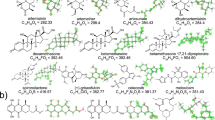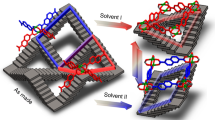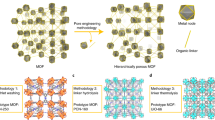Abstract
Metal–organic coordination networks (MOCNs) have attracted wide interest because they provide a novel route towards porous materials that may find applications in molecular recognition, catalysis, gas storage and separation1,2. The so-called rational design principle—synthesis of materials with predictable structures and properties—has been explored using appropriate organic molecular linkers connecting to metal nodes to control pore size and functionality of open coordination networks3,4,5,6,7,8,9. Here we demonstrate the fabrication of surface-supported MOCNs comprising tailored pore sizes and chemical functionality by the modular assembly of polytopic organic carboxylate linker molecules and iron atoms on a Cu(100) surface under ultra-high-vacuum conditions. These arrays provide versatile templates for the handling and organization of functional species at the nanoscale, as is demonstrated by their use to accommodate C60 guest molecules. Temperature-controlled studies reveal, at the single-molecule level, how pore size and chemical functionality determine the host–guest interactions.
This is a preview of subscription content, access via your institution
Access options
Subscribe to this journal
Receive 12 print issues and online access
$259.00 per year
only $21.58 per issue
Buy this article
- Purchase on Springer Link
- Instant access to full article PDF
Prices may be subject to local taxes which are calculated during checkout




Similar content being viewed by others
References
Davis, M.E. Ordered porous materials for emerging applications. Nature 417, 813–821 (2002).
Stein, A. Advances in microporous and mesoporous solids - highlights of recent progress. Adv. Mater. 15, 763–775 (2003).
Yaghi, O.M. et al. Reticular synthesis and the design of new materials. Nature 423, 705–714 (2003).
Fujita, M. Molecular paneling through metal-directed self-assembly. Struct. Bond. 96, 177–201 (2000).
Seo, J.S. et al. A homochiral metal-organic porous material for enantioselective separation and catalysis. Nature 404, 982–986 (2000).
Biradha, K., Hongo, Y. & Fujita, M. Open square-grid coordination polymers of the dimensions 20 × 20 Å: Remarkably stable and crystalline solids even after guest removal. Angew. Chem. Intl Edn 39, 3843–3845 (2000).
Eddaoudi, M. et al. Modular chemistry: Secondary building units as a basis for the design of highly porous and robust metal-organic carboxylate networks. Acc. Chem. Res. 34, 319–330 (2001).
Eddaoudi, M. et al. Systematic design of pore size and functionality in isoreticular MOFs and their application in methane storage. Science 295, 469–472 (2002).
Rosi, N.R. et al. Hydrogen storage in microporous metal-organic frameworks. Science 300, 1127–1129 (2003).
Dmitriev, A., Spillmann, H., Lin, N., Barth, J.V. & Kern, K. Modular assembly of two-dimensional metal-organic coordination networks at a metal surface. Angew. Chem. Intl Edn 42, 2670–2673 (2003).
Chui, S.S.-Y., Lo, S.M.-F., Charmant, J.P.H., Orpen, A.G. & Williams, I.D. A chemically functionalizable nanoporous material [Cu3(TMA)2(H2O)3]n . Science 283, 1148–1150 (1999).
Mori, W. & Takamizawa, S. Microporous materials of metal carboxylates. J. Sol. Chem. 152, 120–129 (2000).
Moulton, B., Lu, J., Hajndl, R., Hariharan, S. & Zaworotko, M.J. Crystal engineering of a nanoscale Kagomé lattice. Angew. Chem. Intl Edn 41, 2821–2824 (2002).
Maspoch, D. et al. A nanoporous molecular magnet with reversible solvent-induced mechanical and magnetic properties. Nature Mater. 2, 190–195 (2003).
Lin, N., Dmitriev, A., Weckesser, J., Barth, J.V. & Kern, K. Real-time single-molecule imaging of the formation and dynamics of coordination compounds. Angew. Chem. Intl Edn 41, 4779–4783 (2002).
Messina, P. et al. Direct observation of chiral metal-organic complexes assembled on a Cu(100) surface. J. Am. Chem. Soc. 124, 14000–14001 (2002).
Lingenfelder, M. et al. Towards surface-supported supramolecular architectures: Tailored coordination assembly of 1,4-benezendicarboxylate and Fe on Cu(100). Chem. Eur. J. (in the press).
Theobald, J.A., Oxtoby, N.S., Phillips, M.A., Champness, N.R. & Beton, P.H. Controlling molecular deposition and layer structure with supramolecular surface assemblies. Nature 424, 1029–1031 (2003).
Rudolf, P. in Proceedings of the International Winterschool on Electronic Properties of Novel Materials. Fullerenes and Fullerene Nanostructures (eds Kuzmany, H., Fink, J., Mehring, M. & Roth, S.) 263–275 (World Scientific, Singapore, 1996).
Hamza, A.V. in Fullerenes: Chemistry, Physics and Technology (eds Kadish, K.M. & Ruoff, R.S.) 531–554 (Wiley, New York, 2000).
Lee, K., Song, H. & Park, J.T. [60]Fullerene - metal cluster complexes: novel bonding modes and electronic communication. Acc. Chem. Res. 36, 78–86 (2003).
Abel, M. et al. Scanning tunneling microscopy and x-ray photoelectron diffraction investigation of C60 films on Cu(100). Phys. Rev. B 67, 245407 (2003).
Fasel, R., Agostino, R.G., Aebi, P. & Schlapbach, L. Unusual molecular orientation and frozen librational motion of C60 on Cu(110). Phys. Rev. B. 60, 4517–4520 (1999).
Campbell, T.W. Dicarboxylation of terphenyl. J. Am. Chem. Soc. 82, 3126–3128 (1962).
Author information
Authors and Affiliations
Corresponding authors
Ethics declarations
Competing interests
The authors declare no competing financial interests.
Rights and permissions
About this article
Cite this article
Stepanow, S., Lingenfelder, M., Dmitriev, A. et al. Steering molecular organization and host–guest interactions using two-dimensional nanoporous coordination systems. Nature Mater 3, 229–233 (2004). https://doi.org/10.1038/nmat1088
Received:
Accepted:
Published:
Issue Date:
DOI: https://doi.org/10.1038/nmat1088
This article is cited by
-
Nearly-freestanding supramolecular assembly with tunable structural properties
Scientific Reports (2023)
-
Calculation of infrared spectra for adsorbed molecules from the dipole autocorrelation function
Theoretical Chemistry Accounts (2022)
-
Investigation of charge transfer between donor and acceptor for small-molecule organic solar cells by scanning tunneling microscopy and ultrafast transient absorption spectroscopy
Nano Research (2022)
-
Novel Self-assembly Coordination Lipid Polymers that Fold into Toroids with DNA-Delivery Potential
Journal of Inorganic and Organometallic Polymers and Materials (2021)
-
Effect of confinement space on adsorption energy and electronic structure of molecule-metal pairs
Structural Chemistry (2020)



